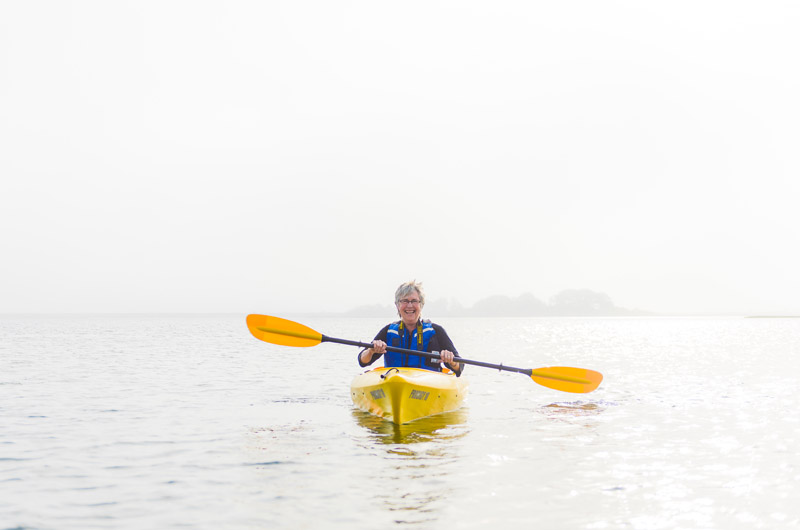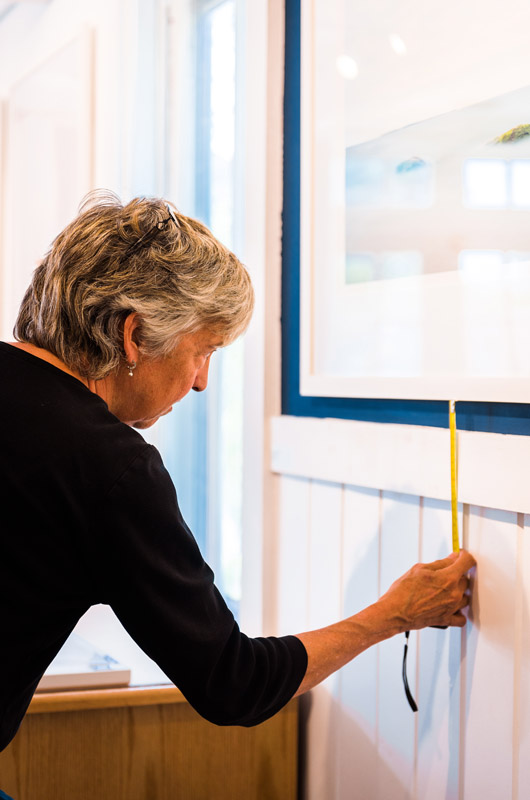It’s early on a foggy morning and Alison Shaw is delighted by what she sees. She is perched in her bright yellow kayak, wearing a blue life vest and snapping photos with her Nikon D810 of a few oyster catchers on a small island in the middle of Sengekontacket Pond.
“I didn’t expect to see so much bird life out here,” the well-known photographer says. “Nesting terns, sanderlings, geese, swans. This is great. The pond by our old house was small — a three minute experience. This is big, much bigger than I imagined.”
Yesterday, after living in the same house in Oak Bluffs for 29 years, Alison and her family moved to a new house nestled in the woods behind Sengekontacket Pond in Edgartown. Rather than spending the morning unpacking boxes, Alison’s first instinct is to go out and document her new surroundings.
“In that house, I always knew what the weather was doing, what the wind speed was,” she says, thinking about her old surroundings. “Now I’m going to have to learn how to read the trees around my house. This morning I had no sense of what it was like out. If I had known it was going to be this foggy and calm, I might have come out even earlier.”
Alison looks down at her camera.
“I’m using boring lenses right now [a 35 MM and a 55MM],” she says. “I used to argue for the extremes — a 20MM and a 200MM — to try to alter reality more with my lens choice. Now my approach and framing is more straight on, more what your eyes see.”
She continues: “This is a really old lens that doesn’t synchronize with the camera so I don’t have a light meter. It’s what’s called a prime lens. No auto focus. I’ve done tests — I test everything — taking the same photo with the same camera just a different, newer 35MM lens and I’ve proven that my old 35MM lens is just as good as the new ones if not better. I don’t like buying new stuff unless there’s a really good reason. You know, people think that taking pictures is just pressing a button. Not so.”
Just then something in the distance catches her eye.
“What are all those dots over there? I think that is Sarson’s Island. The last time I was on Sarson’s Island was when I was shooting for the Gazette in the late seventies. I was with Gus Ben David.”
Alison places her camera into her time-tested water protection system — a 25-year-old camera bag tucked into a large green garbage bag. As she paddles to get a closer look at the dots, she remembers her early days on the Vineyard — Helios restaurant for brunch, the food co-op where she bought brown rice and carrots, the artists co-op.
The oldest of three kids, she grew up in Kensington, Md. and first came to the Island as a child to visit her grandparents who retired here in the mid 1950s.
“They had this gorgeous home on South Water street. We’d come up for a couple of weeks every summer. It was not my home, but it was an emotional home,” she recalls. “It was the kind of deep connection where I would cry when I’d arrive and when I left.”
When Alison graduated from Smith College in 1975, she got a job at the Vineyard Gazette.
“Dick and Mary Jo Reston were running it. I was an inserter.” This meant she was one of the many people who manually put the newspaper sections together once they were printed.
“I was the fastest,” Alison says with a grin.
She came up through the ranks at the Gazette, from her early days inserting and operating the Addressograph, a machine that printed the addresses of each subscriber on the newspaper. She also burned plates, stripped negatives, pasted up ads and assisted on the press. At some point, she can’t remember exactly when during her 25-year tenure at the paper, she moved up to become production manager, and finally director of graphics and design for the Gazette, a position she held for many years. She later also helped the newspaper relaunch and redesign the Martha’s Vineyard Magazine, serving as art director for the publication.
And along the way, her trusty Nikon at her side, Alison Shaw built her reputation as a high-quality photographer.
“I started taking pictures for the paper right away,” she recalls. “They were really bad and infrequently published, but it gave me a foot in the door. I fell in love with the paper. I loved that we had a job we had to get done. So much work happened at 2 a.m. It was not infrequent that we’d pull an all-nighter to make the press deadline.”
As the early morning light fades, Alison paddles back to her silver Toyota Forerunner, which has 180,000 miles on it. She loads the kayak into the back, drives to her new house to drop it off, then heads to a cafe in downtown Edgartown to meet her wife Sue Dawson and their 20-year-old daughter Sarah Dawson. Alison and Sue also have a 17-year-old son, Jesse, who is a student at the Martha’s Vineyard Regional High School. This fall Sarah will be a sophomore at the University of Vermont.
Alison and Sue met in 1987 while they were both working at the Vineyard Gazette. They have been together for 29 years, and have married twice — in a religious ceremony in 1994, and again, 10 years later to the day, in a civil ceremony performed by Sue’s father, an Episcopal priest.
They are also partners in work, and this year are celebrating their 10th year as co-owners of The Alison Shaw Gallery, housed in a former firehouse in the Oak Bluffs arts district. Sue manages much of the gallery’s day-to-day business and handles marketing, design and the website. She and Alison also run a photography mentorship program.
Alison’s phone dings and she looks at it. It is their son Jesse needing a ride to Oak Bluffs to work with music teacher Brian Weiland at the Oak Bluffs School.
“When I first got one of these [an iPhone], I was like a kid in a candy store, taking photos of everything, downloading apps,” she says. “But this only lasted for maybe six months. When you blow the images up, everything gets weird – the tones, the shadows, pixels. Taking the iPhone on and mastering it and learning how — if possible — to manipulate it, felt like a monster that I didn’t want to pursue.”
After dropping Jesse off, Alison makes her way to the gallery. Upstairs, she meets with studio manager Claire Cain who has several freshly-printed photographs for her to sign. Alison examines a few other photographs that Claire has for her to see.
“I clearly get fixated on certain things,” she says. “The jetty near my old house. The fishing pier.”
She pauses to inspect a blown-up image of a ferry, which she notes is blurry. “When you blow things up, every technical shortcoming shows up. I try to make these little itty bitty changes. F4 or F8 is sharp. F16 isn’t. Wide open sucks,” she says bluntly.
Next she has a video conference with one of her students. Every year, Alison and Sue take on a group of photographers and help them refine their craft.

“I am happy I am self taught,” Alison says. “I once went to a critique with George Tice who told me I was doing everything wrong. He is the ultimate gray photographer and I was making these high-contrast images. One of my favorite things that I do with my students is to give them a list of all the ridiculous rules from all the how-to photo books and tell them to break all of the rules.”
Alison may not have had formal training, but she did have the good fortune to know Alfred Eisenstaedt, whom she says was “quietly supportive.” She recalls him coming to one of her shows at the Granary Gallery and sitting in front of her work for an hour.
“I felt he approved of what I was doing in black and white.”
He invited her to be present when he took a family portrait of the Clintons at the Granary Gallery.
“It was so cool,” she says.
When the video conference is finished, she sighs and glances at the photograph of her mother that faces her at her desk. It’s a classically beautiful 1940s portrait. Her mother is holding a camera.
“She raised three kids, but she was a photographer. My dad was an architect,” Alison says.
Sue arrives at the gallery and the three women head downstairs to hang some new framed photographs in preparation for the season’s opening. Alison begins pulling last year’s pictures off the walls. “I used to be into highly saturated colors. Now I am into lower contrast, monochrome,” she says. “My images are quieter, have longer exposures. What really turns me on though is weather. Hurricanes, blizzards, ice. I can shoot 12 hours a day if that is happening. Two years ago, the snow, I was obsessed. This year there was that one day when the snow was falling, big fluffy flakes. Every time I got to a location to shoot, the snow eased up. It was so frustrating. Fall is definitely my favorite time to shoot. Sunrise is later. Sunset is earlier.”
As she talks, she climbs up and down a small step ladder, measuring, hanging, looking at the photograph on the wall, taking an image down, adjusting the hook up or down by a half, quarter or eighth of an inch, then hanging the picture again. She fiddles with each one until she is satisfied.
“There’s always more to do here,” she says as she straightens several racks of posters and images for sale. There’s her iconic shot of Makonikey Beach that is tinged with green. Pictures of shoes neatly parked on a deck. A coffee can of flowers. Blueberries lined up for sale at the Farmer’s Market. Fog, lighthouses, oceans, snow, shorebirds, Lucy Vincent Beach, the Gay Head Light, Gannon and Benjamin Boat Yard, the Agricultural Fair.
“My early work was more about the visual identity of the Island. Now it is more obscure, subtler, bits and pieces, more personal.” She points to a photograph hanging behind Sue’s desk, an image of pilings that appear to float in the fog. “Most people don’t know where that is. It isn’t necessarily the Vineyard, but it is. That’s Katama Bay.”
The images as a whole are a reminder that for the past 40 years, Alison Shaw’s photographs have been shaping the way we see the Island, the emotional quiet of our water ways, the rich palette of our farms and fields, and the depth not just of our piers but of our community itself.
Alison Shaw Decisive Moments
Age: 62
Profession: Photographer.
Spouse: Sue Dawson.
Children: Sarah Shaw Dawson, 20, Jesse Shaw Dawson, 17.
Camera: Nikon D810.
Number of photographs taken in the last 40 years: “Easily more than 250,000 pictures.”
Prints published and sold: More than 8,000 .
Books with her images featured in them: 19.
Pets: 2 cats, Ashley and Rozie.
Favorite foods: Lobster, lasagna.










Comments (18)
Comments
Comment policy »